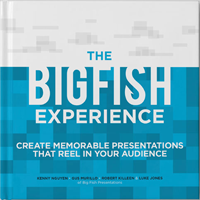Big Fish Employee Spotlight: Production Director Phil Roberts
Clients frequently request video production or motion graphics to implement into presentations.
Why?
It’s because people are tired of boring, predictable PowerPoint slides. Adding video or animation serves as the visual eye candy that gives the audience a break from stale text. Learning the software and producing visuals is a strenuous and time-consuming task. It’s a task Phil Roberts, Head of Production, has mastered. He’s been working with production tools and software for a long time, so we wanted to sit down and talk about his work and what he’s learned about animation and film.
When did you first learn about using animation software and filming?
I took a digital media class in high school (2008) and that got me interested in filming. The class also focused on very basic motion graphics, but that didn’t intrigue me enough. I preferred the filming aspect, so I did everything I could to learn as much as I could. It wasn’t until Big Fish’s Creative Director, Mitch, joined the team that I truly became interested in animating. He showed me the possibilities and I hit the ground running.
My advice for anyone interested in learning film or animation is to first get your hands on the software. A lot of programs will give away demo versions for free, but it’s very important to become familiar with the software by using it frequently. The Internet is a great source of information, so take advantage of it. I’ve learned most of what I know from looking at tutorials online, reading forums, and just experimenting with the software. It’s a great place to find inspiration for your next project.
What’s the coolest thing you have seen recently in production or motion graphics?
Everywhere you look, someone is doing something groundbreaking or innovative. Although I’ve been learning motion graphics, cinematography will always be my passion. But some of the most interesting things I’ve seen lately involve test footage of new cameras. I love seeing what new cameras can produce and how we can push beyond the limits we used to think were impossible to reach. For motion graphics, I have noticed that everything is getting cleaner and simpler. It isn’t about being big and loud anymore; it’s more about being subtle.
What’s the process of creating motion graphics or film production?
Once we evaluate the client’s problem, we decide what medium would be best to communicate their message. Our team then works together with the client to produce a script, storyboard, or shot-list, and then the final product. We always make sure we lock down one phase of the project before moving on to the next, because it’s not a lot of fun to go back and change the script when you’re in the middle of animating. But once the first draft is complete, we send it to our client and they let us know if they have any revisions. The final files are sent after the revisions have been made and that’s basically the final piece to the puzzle.
What’s the hardest part of this process?
Organization. Being organized is very important when it comes to creating these kinds of videos. For film, you have to make sure every shot is planned for and ready to go. You need to make sure all your equipment’s charged and packed up, the location has to be locked down, and all actors need to be there on time in the right wardrobe. This is only possible with good organization. For animation, you have to think about how you’re going to do it before you even start. The programs I use to animate can get very confusing and cluttered, because there’s hundreds of ways to create the same animation. You have to think about it and pick the way that makes it easiest for you.
How do you stay on your game in order to keep up with competitors?
I am constantly checking out what our competitors are doing, along with the industry as a whole. Not only is this a good source of inspiration, but it also helps you notice trends. This lets you either conform to the popular techniques or branch out and do something completely different, yet similar. A lot of tutorials, videos, books, articles, etc., etc. In this field, you’re never done learning. The moment you think you think you’re done learning is the moment you fall behind. You have to constantly push yourself to be more creative. That’s the fun part.
Animation and motion graphics are starting to appear more and more in presentations. This is why it’s important to keep up with the trends and include them in your next presentation. Grab the crowd’s attention with something they won’t expect. Like Phil said, you can teach yourself and constantly learn to push yourself to be better and better. To see some of the animation Big Fish has done, check out some of our videos here.
Like what you’ve read?
There’s more where this came from if you subscribe to the Big Fish Presentations blog.




Share your opinion.